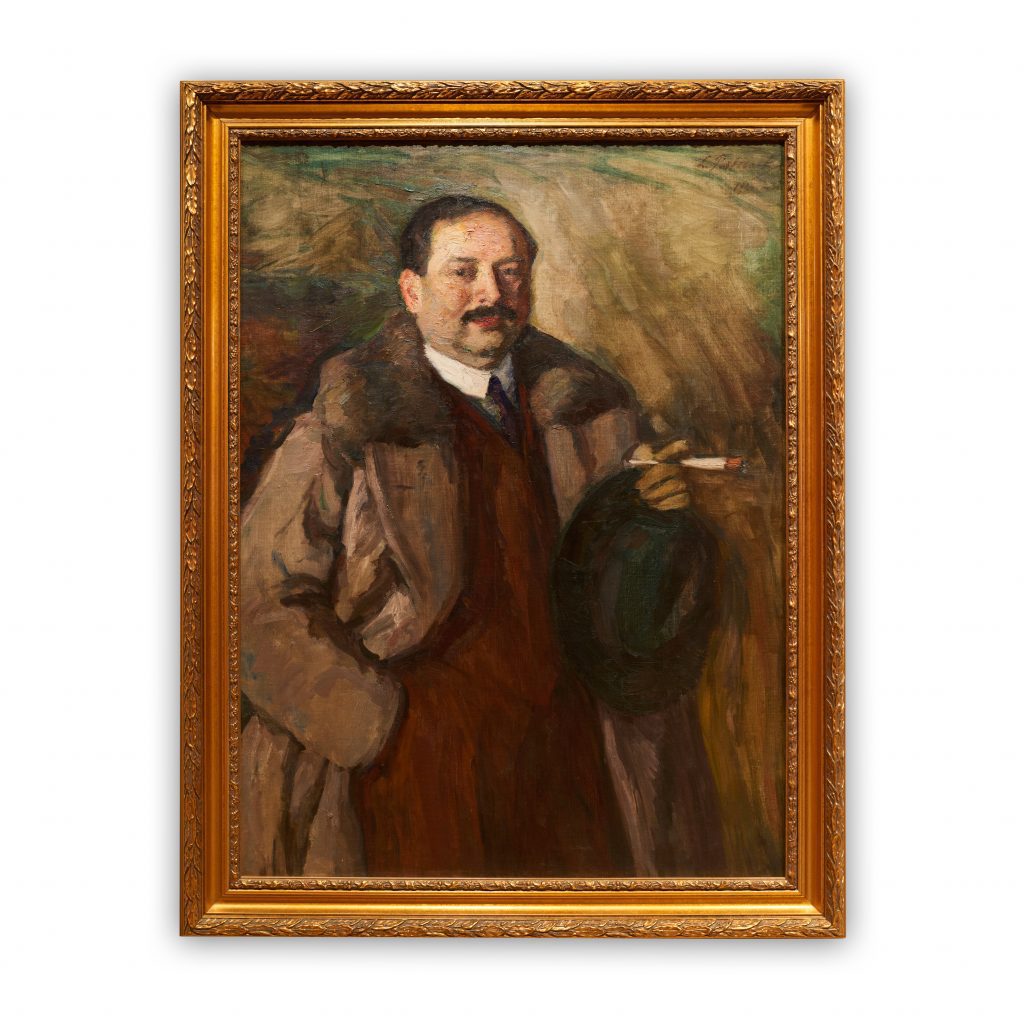Leonid Pasternak Portrait of Alfréd Manovill, 1926
Oil on canvas
Gift of Alfred I. Tauber, M.D., in loving memory of his grandfather, Alfréd Manovill.
Must Know
Alfréd Manovill was born to a poor family in Veszprem, Hungary. In 1904 he moved to Berlin, where he ascended the ranks of Weimar society, eventually becoming the official representative of Mendelssohn & Co., the most important private bank in Germany. Generous with his wealth, Manovill became a well-known philanthropist, a patron of the arts and sciences, and a major supporter of Berlin’s “Hungarian colony.” In 1934, following the rise of Hitler, he returned with his family to Budapest, where a decade later he died impoverished, overcome by the events of World War II.
This portrait shows Alfréd Manovill at 46. Dressed in an elegant dark three-piece suit and a beige fur-collared coat, he holds a cigarette and Homburg hat in one hand while the other rests in his trouser pocket. Radiating confidence and contentment, it is hard to imagine him having a worry in the world. This is one of four portraits of Manovill and his family that were painted in 1924-1926.
More Info
Shortly after the end of World War I, Alfréd was promoted to a powerful position managing Mendelssohn Bank’s activities within the stock exchange. This post gave him “full signatory” authority, meaning he was vested with power of commercial representation and thus to serve as a proxy for the owners of the firm. The bank’s trust in him proved well-placed. Alfréd successfully navigated the inflation panic of the early Weimar period and the growing unemployment and economic depression that marred Germany’s economy throughout the 1920s. he was widely acknowledged for his financial acumen and his indispensable contribution to Mendelssohn & Co.’s robust financial health. “The fact that the Mendelssohn Bank is one of today’s most prestigious banking houses,” wrote the Berlini Futár in September 1932, “is largely due to Alfréd Manovill’s creative work.” It was “thanks to him alone,” the paper averred, that Mendelssohn & Co. had weathered so successfully the global economic storm.
It was fashionable for members of the German elite to have their portraits painted by renowned artists. Max Liebermann and Max Slevogt were the most celebrated establishment artists in 1920s Berlin, and their brushwork lent a certain aura and cachet to the famous and powerful people whose portraits they painted. Leonid Pasternak (1862-1945), born in Odessa to an Orthodox Jewish family, was not in the same league as Liebermann and Slevogt, but the impressionist painter – and father of the novelist and future Nobel laureate Boris Pasternak – had slowly built a reputation since moving to Berlin in 1921. Pasternak had already made a name for himself in Russia as a professor at the Moscow School of Painting, Sculpture and Architecture, and as a member of Russia’s realist and impressionist movements. In Berlin, where he was relatively unknown, Pasternak supported himself chiefly by commissions, painting portraits of artistic, scientific, and other public figures, as well as various members of Berlin’s social élite.
Alfréd Manovill could have met Pasternak any number of ways. Franz von Mendelssohn, Alfréd’s immediate superior at the bank, was on “very good terms” with the renowned church historian Adolf von Harnack; Harnack had sat for one of Pasternak’s first Berlin portraits. Furthermore, Pasternak’s son-in-law and cousin, Friedrich Pasternak, worked at the Bayerische Vereinsbank in Munich, which had entered a “community of interest” with Mendelssohn & Co. in 1922. Most likely, through this webbing of personal and professional networks, Pasternak encountered Manovill, leaving us with this portrait of an accomplished man standing securely at the top of his world.

